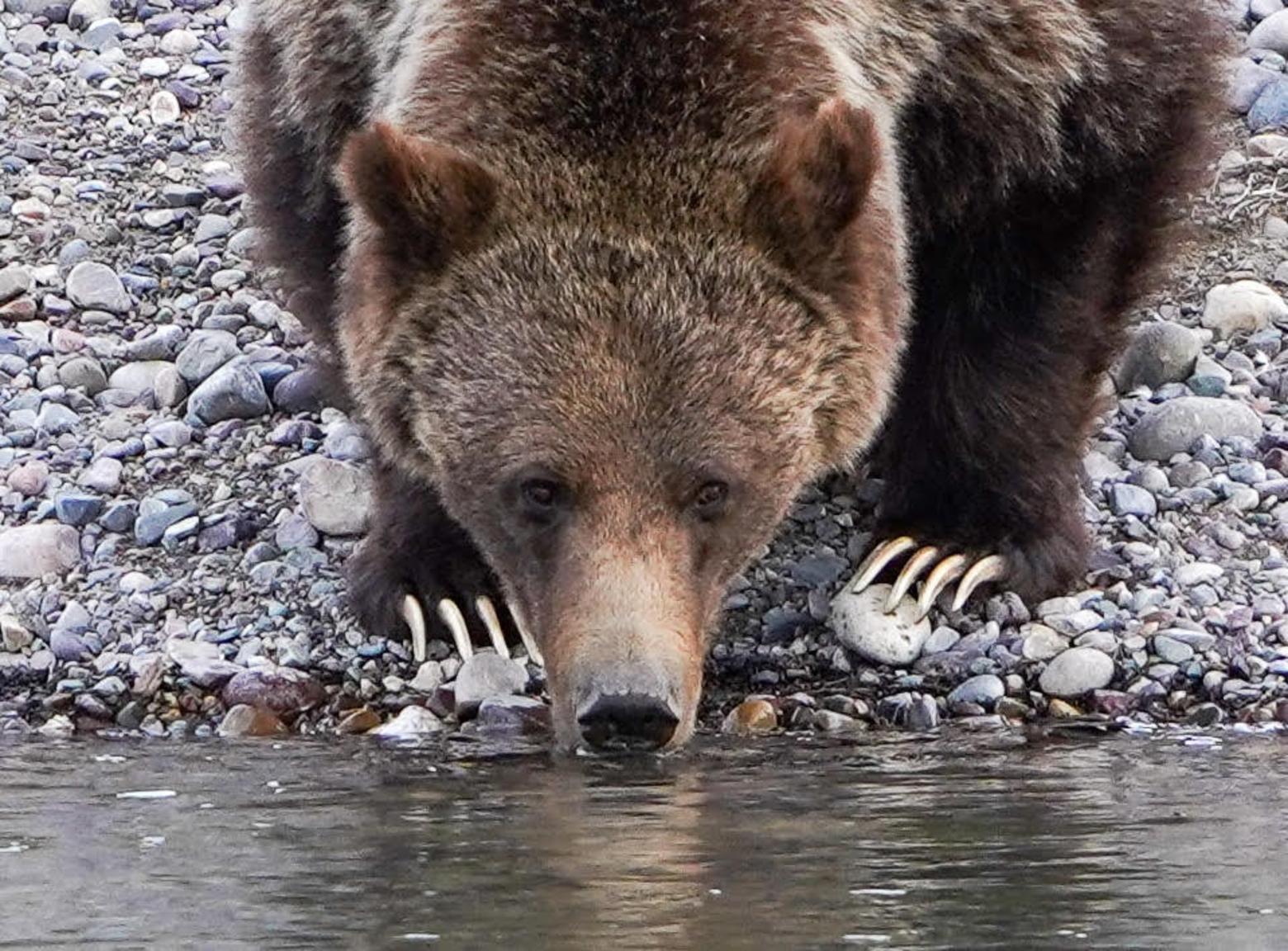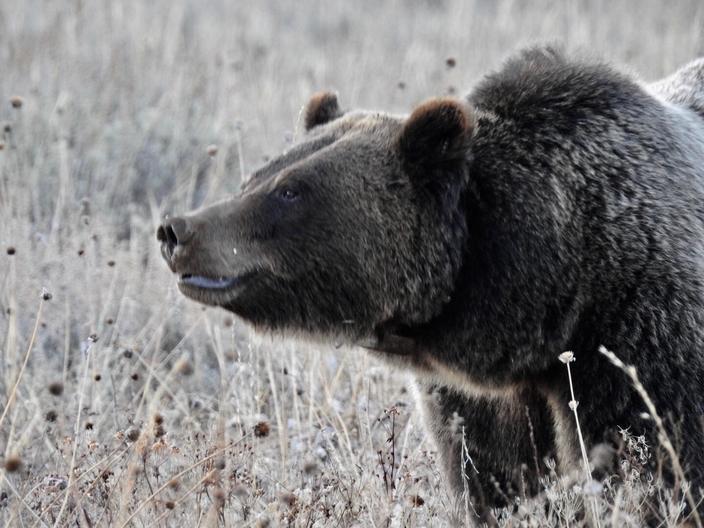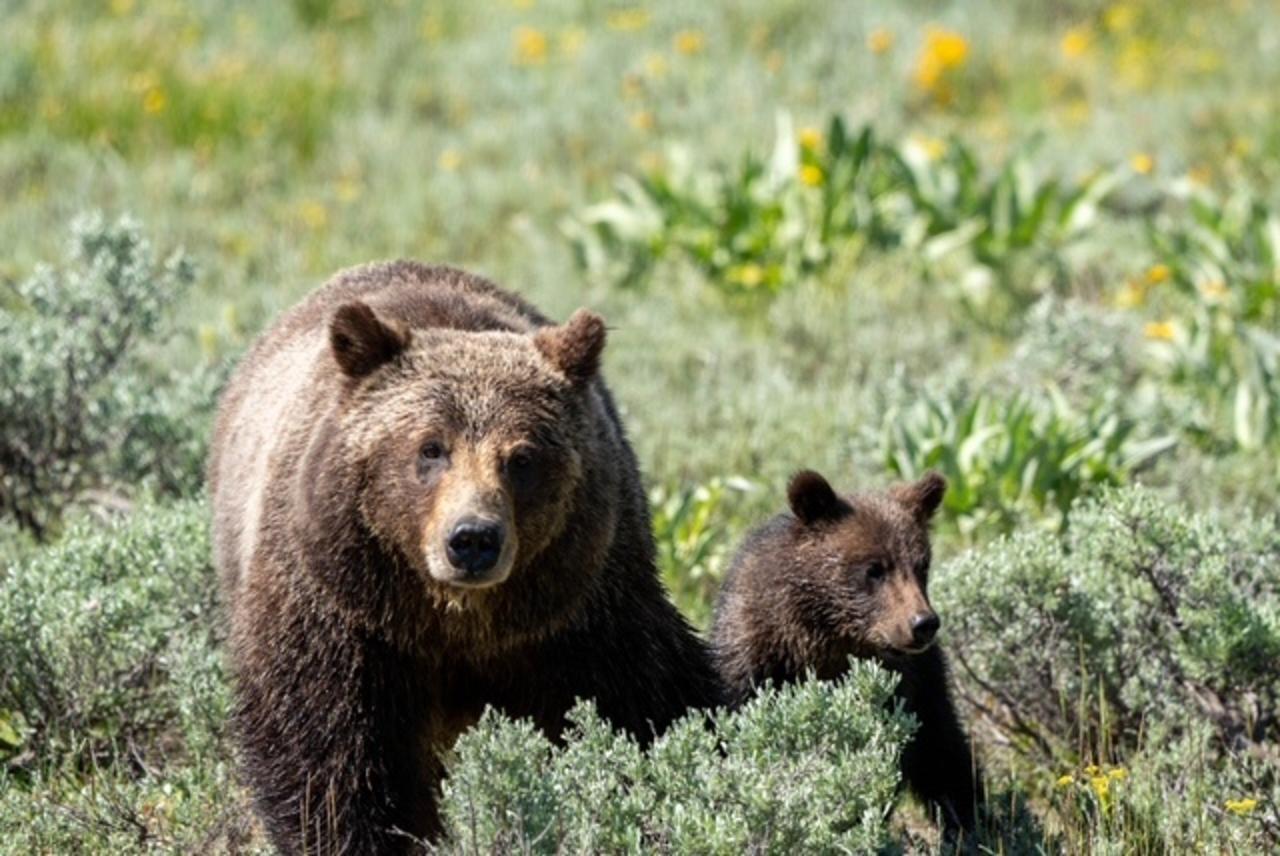Back to StoriesGrizzly 399: The Monarch of Conservation
October 30, 2024
Grizzly 399: The Monarch of Conservation A national park wildlife guide reflects on the life of the most famous grizzly bear in history
Story and Photos by Monica
Robinson
The night
of Tuesday, October 22, 2024 was the vehicle collision heard around the world. Famed
and beloved Grizzly Bear 399 was dead.
An
outpouring of shock, grief and love for the 28-year-old sow flooded social
media outlets in every corner. Major news networks reported on the incident.
Stories, photos and memories dominated the day for all who had followed the bruin
in any capacity. The reaction to her loss was no less than that of a beloved
human celebrity. She inspired countless books, artwork and a dedicated
documentary. She even has her own social media accounts. Unwittingly, she was
at the helm of grizzly conservation.
Grizzly
bears are an enduring icon of the American West. At their peak, they numbered
more than 50,000 in a contiguous range, roaming from the Pacific Coast to the
Mississippi River and stretching from Alaska down to Central Mexico. Fears for
human safety and livestock during European settlement impeded westward expansion,
prompting extermination efforts by the government in the 1800s. Reduced to
numbers estimated around 700-800, the grizzly bear occupied only 2 percent of
its historic range in the Lower 48 by the time it was listed as a threatened
species by the Endangered Species Act in 1975. Today, the sight of a grizzly on
our public lands is thanks to persistent conservation efforts successfully
recovering the population, although still only within 6 percent of its historic
range in the contiguous U.S.
During this
critical recovery period, in 1996, Grizzly 399 was born. Frank van Manen,
leader of the Interagency Grizzly Bear Study Team, says that the grizzly’s
recruitment rate—the percentage of cubs surviving into independence—is around 30
percent. While that number may have differed slightly at the time of her birth,
399 beat the odds and continued to thrive, producing 18 cubs of her own
throughout her lifetime and becoming arguably the most famous wild grizzly bear
in history.
“The Matriarch
of the Tetons,” as 399 is known, was not the first wild animal to be adored by
the public, and she won’t be the last. The impact, however, that she had on the
local community and nature enthusiasts around the world was unlike anything
I’ve ever seen before. I’ve witnessed elephants and rhinos steal the hearts of
people in South Africa and dolphins in Ireland become renowned worldwide. But
the reach 399 had beyond the park, even beyond the region, is astonishing.
As a
wildlife guide in Grand Teton and Yellowstone national parks since 2017, I had
my fair share of encounters with 399. Some were quiet, intimate moments without
fuss or fanfare, but most others were the classic “bear jam” scene: roadsides
densely lined with exhilarated people armed with phone cameras, spotting scopes
and enormous professional lenses. These crowds get bigger every year.
As prominent as 399 was for so many years, it was difficult, if not impossible, to avoid becoming emotionally attached. After all, we are only human.
In the
quieter moments with her, I get to see her be herself: a bear. The only thing
that set her apart from other grizzlies in the ecosystem are her small, black
ear tags. There is nothing remarkable, other than the fact that she is, of
course, a grizzly bear. During the bear jams, it was a different story. The
scene is charged with a unique energy. People are running frantically to capture
any sort of a photograph they can, and cars are moments from fender benders as
they roll slowly past, drivers craning necks out windows to catch a glimpse. Just
about everybody who gets in my vehicle wants to see a grizzly. Rounding the
corner to a chaotic bear jam became a relief; I was always very grateful when
she was in view and quick to find. She made my job easier, and she frequently
gave me happy clients who could say they saw one on their visit. I took
satisfaction that I could give them the special experience of witnessing a
grizzly in the wild.
As time
went by, though, it wasn’t just about seeing a grizzly bear, it was about
seeing her. People from all over would ask me about 399 before we even
entered the park. Some booked the tour with the primary goal of seeing her.
Some would be disappointed that the grizzly we did get to see was not 399. This
often led to a discussion about how she is special because she is a grizzly,
not because she is 399, and seeing any grizzly is an incredible privilege. Talks
like these were a reminder to myself, also, to try to remain impartial and
scientific.
This topic
frequently sparks conversations in the guiding community about the dangers of
naming individual animals and idolizing them, instead seeing them for what they
are to avoid anthropomorphizing; knowing the difference between science and
feelings, and the danger of operating within the conservation world led by your
emotions. But clearly, things are not so black and white.
During
these bear jams, viewers often expressed concern for her, worrying that she
might be stressed or overwhelmed by the gathering crowds. Our wild residents
are, if anything, adaptable survivors. 399 inhabited a vast territory and moved
through it swiftly with ease, even with several cubs in tow. She was not only
experienced with roads and crowds, but used them to her advantage. Sows with
cubs are known to spend time closer to roadsides to keep male bears at bay who
are not as tolerant to human presence. This is a strategy to keep their cubs
safe, since male bears commonly kill cubs they cross paths with.
It became
somewhat of a symbiotic relationship of mutualism between bear and human as 399
provided enjoyment to onlookers in exchange for a degree of protection. Thanks
to Grand Teton’s bear management team, which tirelessly monitors onlookers by
ensuring they keep a safe distance and don’t obstruct her movements, this
likely imposed minimal stress on her as she chose to frequent these areas.
As she
aged, the public held its collective breath each spring, waiting for the first
sighting to confirm her survival through the winter. In the spring of 2020,
just as fears were beginning to rise, she emerged with a staggering litter of
four cubs, a rarity among the species. This set the 399 frenzy into overdrive, giving
people something to celebrate in a particularly dark and uncertain time as the
world faced the Covid-19 pandemic. This litter of cubs, or “The Quads” as they
were affectionately known, provided a much-needed wave of hope and cheer,
cementing 399 in her role to us as a figure of endurance and vitality.
In a
tragic twist last week, her habituated comfort along roadsides ultimately led
to the end of her story on Highway 26/89 in the Snake River Canyon, orphaning
her last, single cub that she birthed in spring of 2023. Officials say they are
confident the yearling cub will have a good chance of survival, though we face
the bitter reality that 399’s method of utilizing human roads, something that
we all benefited from throughout the years, resulted in her death.
399’s long-lived
journey as a grizzly in the Tetons is at once simple and complex. She is both “just
a bear,” and a beloved icon all at once. The thoughts and feelings we project
onto her can be a direct reflection of who we are as people and how we view our
natural world. Perhaps the biggest role that 399 played for us was permitting
us to reflect on the personal relationships we each have with nature, acting as
a mirror for our own individual values in wildlife and conservation, and even
in our own lives.
As a wildlife
guide, one walks a fine line of creating an opportunity for clients to connect
to wildlife in a personal, emotional way, while also remaining objective about animals’
lives in a scientific manner. You explain to them the research behind why wild
animals do what they do, while at the same time feeling moved as you watch tears
of joy roll down their cheeks when they witness it in person. As prominent as 399
was for so many years, it was difficult, if not impossible, to avoid becoming
emotionally attached. After all, we are only human.
To deny
our personal and collective affection for a particular animal for the goal of
objective science is in the same breath to deny the human condition. Both
things can be true, but without the passion that 399 ignited in a generation,
we would not have the same communal dedication for local wildlife conservation
that we have today.
Regardless
of your feelings on the matter, the bear that is just a bear will forever be a
legend.
After earning a master’s degree in wildlife conservation and
management, Monica Robinson began working as a wildlife guide in Grand Teton
and Yellowstone national parks in 2017. When she isn’t guiding, she can be
found in the parks photographing wildlife or writing about the ecosystem.
Related Stories
October 31, 2024
The Halloween Forest
As the seasons change, life and death can blur illuminating
the magic of nature in the pale moonlight of Halloween in Greater...
January 16, 2024
In Cadence: ‘Mni Wiconi’ and the Great Observers
Recalling the 2016 Standing Rock demonstrations protesting the Dakota Access Pipeline, a Lakota woman reflects on the rhythm and power of...
November 22, 2023
The Arrival of Harriman’s Iconic Trumpeter Swans
By the early 1900’s trumpeter swans were nearly extinct, but concerted efforts have reinvigorated their numbers. Land around Harriman Ranch State...




